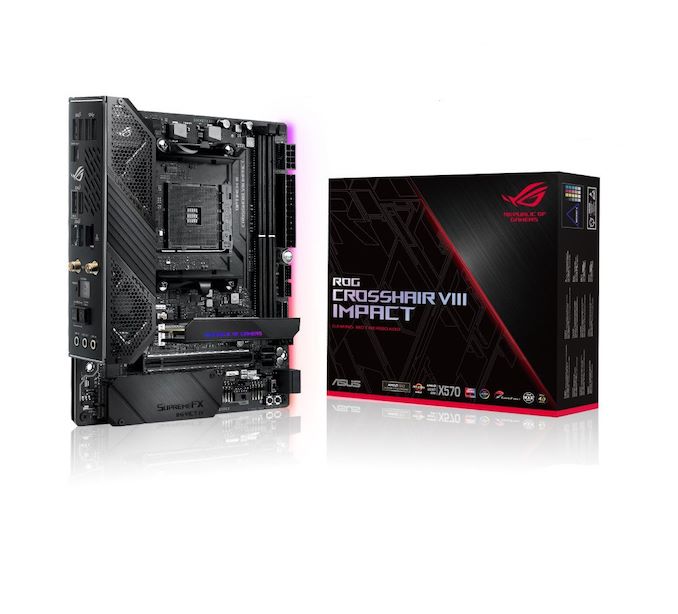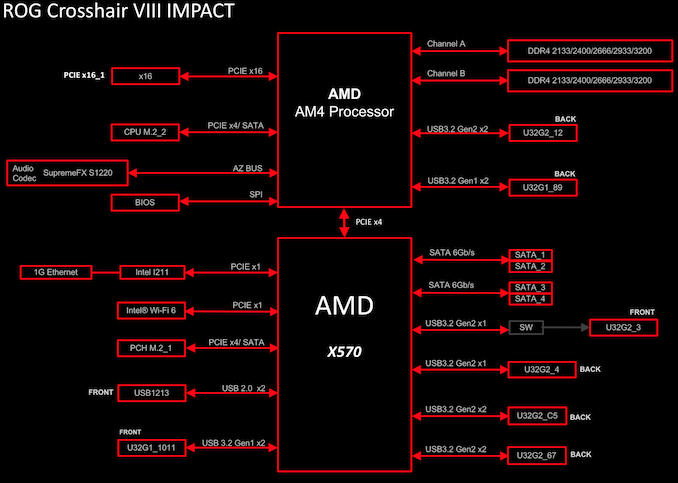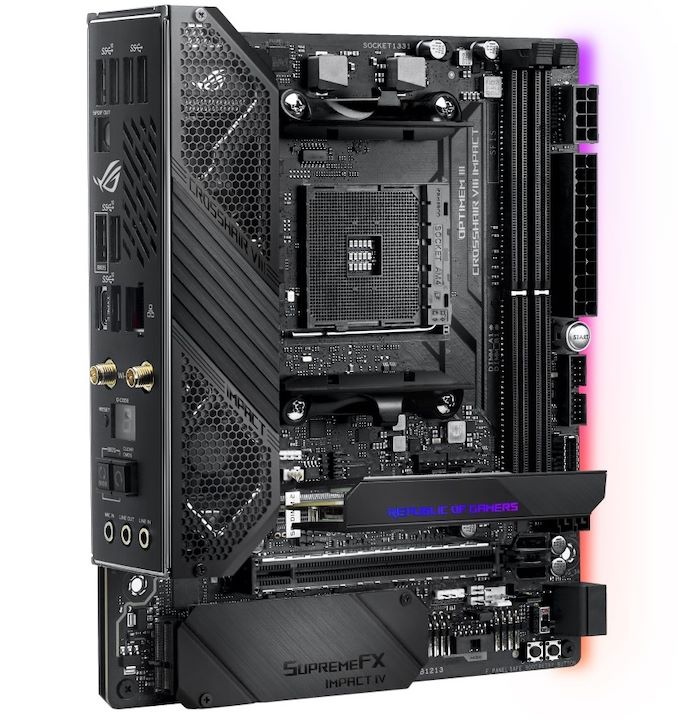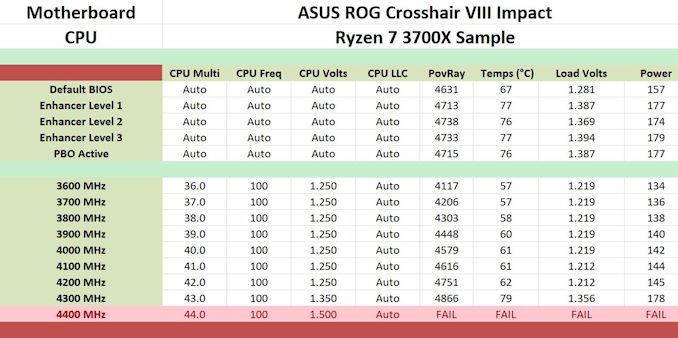The ASUS ROG Crosshair VIII Impact: A Sharp $430 Impulse on X570
by Gavin Bonshor on October 25, 2019 11:30 AM EST
One of the most interesting unveilings from the X570 launch earlier this year came from ASUS, with the reintroduction of the ROG Impact series of small form factor motherboards. Not seen since the days of Intel Z170 days, the ASUS ROG Crosshair VIII Impact is the first truly AMD high-end SFF model from the vendor. Accompanied by its SO-DIMM.2 slot for dual PCIe 4.0 x4 M.2 SSDs, a SupremeFX S1220 HD audio codec and support for up to DDR4-4800 memory, the Impact looks to leave its mark on AM4 for enthusiasts just like previous iterations have done on Intel platforms. The only difference this time round is that it's not a true Mini-ITX like the previous Impact designs.
What Is Mini-DTX?
When ASUS unveiled the ROG Crosshair VIII Impact, a lot of users were somewhat confused as to why the manufacturer adopted the unconventional mini-DTX form factor over the more commonly used mini-ITX. One of the primary caveats with small form factors such as mini-ITX is space. The bigger the standard, the more of an advantage features like space for an extra expansion slot can be taken advantage of - it could be the difference between two PCIe 4.0 x4 M.2 slots and none.
In order to best use this space, ASUS has (among other things) included it's special dual M.2 riser module, known as a SO-DIMM.2 slot. This is a way to add dual M.2 slots with a vertical mount to save additional PCB space. It's not the first time it's been done - other high-end models from its line-up including the ASUS ROG Maximus X Apex uses the same technology.
There is also a PCIe 4.0 x4 M.2 slot at the bottom, underneath the full-length PCIe 4.0 x16 slot, but this is populated with a SupremeFX S1220A HD audio codec and ESS ES9023P DAC mounted onto an M.2 add-in card. This saves some PCB space and effectively makes the audio a more modular component.
The ASUS ROG Crosshair VIII Impact also has a single Intel I211-AT Gigabit Ethernet controller as well as an Intel AX200 Wi-Fi 6 wireless interface which provides Wi-Fi and BT 5.0 connectivity. While the board does allow users to use up to two PCIe 4.0 x4 M.2 drives via the SO-DIMM.2 slot, there are also four SATA ports which support RAID 0, 1, and 10 arrays. The slightly larger ROG Crosshair VIII Impact uses the traditional AM4 cooler mounts with a cleaner socket area with not just compatibility with the full range of AM4 coolers, but allows for enthusiasts to install the best cooling in the business without fanfare.
Equipped with a 10-phase power delivery which is running with eight teamed TDA21472 70 A power stages for the CPU are a particular highlight and one that helps justify its enthusiast-level market price of $430. The ASP1405I is an 8-channel PWM controller and is operating in 4+2 mode. The other factor to consider is thermal performance and the Crosshair VIII Impact is using a heatsink across the CPU power delivery section, with a 30 mm cooling fan directing airflow to aid in cooling; there is a second 30 mm fan which is directed over the X570 chipset.
Another enthusiast-level feature is support for DDR4-4800 memory which two slots allowing for users to install up to 64 GB of system memory, as well as supporting the DC double height and double capacity UDIMMs that ASUS supports on its two slot Intel Z390 models.

ASUS ROG Crosshair VIII Impact Block Diagram
Looking at the performance of the ASUS ROG Crosshair VIII Impact in our test suite and it displays a strong and stable showing. In our system-specific tests, the Crosshair VIII Impact posted some of the fastest POST times we have seen from an X570 model, as well as solid results in our power consumption tests. In our computational tests, the X570 Impact also competed well with other models on test with the best performance coming in our 3DPM test; the new highest performer from all X570 models tested. This smaller mini-DTX creation has the equipment to take on its larger flagship counterparts.
One of the biggest aspects to consider when manually overclocking with the ASUS ROG Crosshair VIII Impact is the level of VDroop when the LLC setting is set to automatic. Applying 1.250 V on the CPU VCore between 3.6 and 4.2 GHz on our Ryzen 7 3700X equated to between 1.212 V and 1.219 V at load which is around 0.038 V of VDroop. Moving up to 4.3 GHz which required a CPU VCore value of 1.350 V in the BIOS ran with a load CPU VCore of 1.356 V which was overcompensated by the firmware by just 0.006 V; quite tight and expected given the boards focus for enthusiasts and extreme overclockers. There is an LN2 mode jumper which will bypass certain AMD restrictions for users looking to push silicon to its hard limits, but this should be left well alone for users on ambient cooling. The Precision Boost Overdrive can be enabled but to little effect compared to the default settings with a slight improvement, but the three levels of PBO enhancement proved to be similar in performance with different levels, albeit minimal levels of CPU VCore voltage observed.
As it stands, the ASUS ROG Crosshair VIII Impact is in a product segment of its own. It is the only mini-DTX model in existence in the desktop segment, and we can either compare it to smaller boards or slightly larger boards. Users can make similarities in other small form factor models including the ASUS ROG Strix X570-I Gaming ($299), the recently reviewed ASRock X570 Phantom Gaming-ITX/TB3 ($240) which did impress us, and the GIGABYTE X570 I Aorus Pro WIFI ($220) which at present, is the cheapest small form factor X570 model available on the market. The ASUS ROG Crosshair VIII Impact has a list price of $430 at Newegg and is nearly double the cost of GIGABYTE's mini-ITX model; the Impact is targeted at a much more specific enthusiast level market than the other models with performance and enhanced componentry which further bolsters its high price tag.
Read on for our extended analysis.












59 Comments
View All Comments
evernessince - Saturday, October 26, 2019 - link
It's the same people complaining on every article about the same issue, despite the fact that they've been told time and time again that these fans run at low RPM or off completely when you are not pushing the IO heavily. For most people, they are inaudible 100% of the time. These people want to spin their narrative, not try to understand what people are telling themHardwareDufus - Friday, October 25, 2019 - link
I won't say that I'm disappointed. I like Zen2.... but I will do just one more cycle of waiting.... I want to see the Zen3 successor to the Ryzen 9-3950X... and the RDNA 2 successor to the Radeon RX 5700 XT. That's all probably 12-15 months away, but that's just about right. I too am on an I7-3770k (longest lasting CPU I have ever had as well). This will be the last machine I build of my professional working career (If I've gotten 7+ years out of my I7-3770k, I'm sure I'll get 5 years out of the Zen3 16core CPU).hmmm, my trusty SilverStone SG055BB is mini-ITX / mini-DTX compatible (I own two of them). However, I'd pay a max of $300usd for a board like this (even though admittedly it's just about the perfect board... optical audio out, wifi and 2 M2 slots for storage... I ALWAYS have two harddrives).
We will see if a successor to this board is available in 12-15 months when I make the Ryzen Zen3 & Radeon RDNA-2 jump.
I'll be fine if only PCI4 is supported at that point.... I won't hold off for PCI5 to be implemented.
Will be interesting to see if we start seeing 4TB M.2 storage devices at that point as well... and if 32GB Dimms at good speed will be more affordable. Yeah.. Looking at 16 Cores @ 4Ghz+, 2X32GB for 64GB of Ram, 2X4TB for 8TB of storage to drive 2 32" 4K monitors. Will be a nice rig for the sunset years of my IT career...
alufan - Saturday, October 26, 2019 - link
honestly I do not understand folks who say this you have a CPU that is in modern terms slow and a system thats the same AMD comes along with a really disruptive product that is leagues ahead of what you have and in its third generation yet still you want to wait !What the heck exactly do they need to do to get your buy in, if AMD didnt exist or bring Zen to the party intel would happily keep chugging out its same CPUs for the next 10 years, support the company thats brought the fight to them!
HardwareDufus - Sunday, October 27, 2019 - link
Well, I will build the new system with cash on hand... So I may have misrepresented why I will sit out...... It's just that in my budget at end of 2020/2021 will make room for my computer. By then it will be Ryzen Zen 3 Radeon RDNA-2 and I will be curious to see what they offer... That's all. If their release is stalled significantly... then I 12 months from now I will buy current gen Ryzen Zen 2 Radeon RDNA....and would be equally delighted to do so...HardwareDufus - Sunday, October 27, 2019 - link
But perhaps in that time.... we will see a X570 variant that won't require a fan.... again, won't be a show stopper, as the CPU and Video cards will have fans aplenty anyway.....evernessince - Saturday, October 26, 2019 - link
And yet all X570 motherboards either turn off the fan during low load or run at low RPM, making then inaudible.PeachNCream - Sunday, October 27, 2019 - link
Noise isn't the concern. Fan failure is what bothers the OP as indicated by noting fans are a regression in the movement toward fewer moving parts (which can suffer from mechanical failure). While noise might be a concern, broken little fans that are a PIA to replace are what have peoples' panties in a twist right now and we haven't seen any X570 motherboards operating long enough to get a good understanding of whether or not fan failures are going to be a problem or if, as you implied, they are generally not running to begin with (which begs the question why the motherboard manufacturers are adding them in the first place instead of using a more effective passive heatsink).Oliseo - Sunday, October 27, 2019 - link
But you're not interested in anything but laptops, I don't get why you're arguing with people about something you no longer care about.Just like arguing I suppose.
RavenRampkin - Sunday, October 27, 2019 - link
May I kindly take Peach's initiative? xDNot interested in laptops. Have one, it's fine. The current pricing situation is meh. 6/12 ultrabook and 8/16 laptop parts are crazy expensive. Graphics are expensive (Turing), boring (Turing GTX) or both (Radeon, sadly. Power hogs or underperformers, or both). Zen is a skillful fighter for new users but nothing of particular interest over a good ol' 4700MQ (minus the Vega... got a dGPU anyway)...
As for the fans, sorry bud. If the interested customer has to find ways in which a hackjob (just sry, this IS a hackjob... it's not 2005 anymore) doesn't svck (oh the fans are low RPM, oh they're not that short-lived, oh there's passive mode at 0.1% load) and is actually *not that bad*, then it's not really a good hackjob. The need for this dayum fan in the first place screams a littley oopsie from ASMedia, or a design less efficient than usual on AMD's side. OK higher demands than for 300 and 400 series, then why does Shintel get away without le fans? (Pls correct if wrong.) Also, you can still do it passive, funnily enough. Why should it be a blessing and not a default option?
Case in point right above (or below?) me. Adaptation 100. Spare me some lube guys, been shilling for AyyMD, AsRock, Powercolor and Seasonic long enough :P want to try out some other companies
TL;DR there's no advantage nor purpose in reinventing the sleeve bearing (or dual ball, depends) wheel.
AshlayW - Monday, October 28, 2019 - link
PCI express 4.0 has significantly higher power requirements and thus heat output. X570 chipset is a repurposed Matisse IOD. Why you people complain about the chipset fan is beyond me, always gotta complain about something I guess. It's completely bloody inaudible on my X570M pro 4, and also completely unnecessary for all but the most intense I/o on both gen4 m.2 and the GPU.Stop complaining.